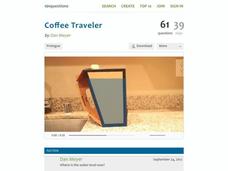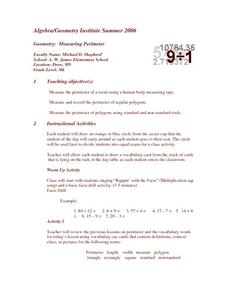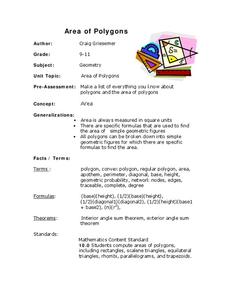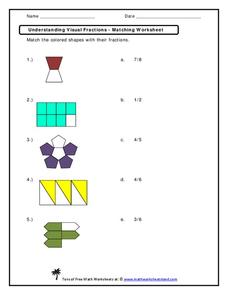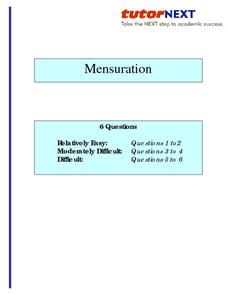101 Questions
Coffee Traveler
Investigate the volume of irregular figures in an inquiry-based exercise. Presented with an irregularly shaped box filled with water, learners must predict the level of water when it is tipped on its side. The class can divide...
Curated OER
Children's Museum of Houston - Pre/Post Classroom Activities - Nets
Students make three dimensional shapes with nets. For this nets lesson, students receive nets which they fold to make a three dimensional object. They predict what shape each net will make and verify it after making the net. They use the...
Curated OER
Geometric Shapes: Review of 2D and 3D Figures
In this geometric shapes worksheet, students identify 4 drawings as polygons or not, 1 drawing as regular or not and then write the name of 3 solid figures.
Curated OER
Measuring Perimeter
Have your class practice measuring the perimeter of various objects using this resource. Fifth graders place various-sized polygons in order (from largest to smallest). They use non-standard measuring tools to estimate the distance...
Curated OER
Area of Polygons
Students engage in a lesson that is about the concept of polygons and focuses upon finding the area. They use formulas provided in the lesson in order to solve problems given by the teacher for independent practice. Geometric figures are...
Curated OER
Interactivate - Lines, Rays, Line Segments, and Planes
Students explore lines, rays, line segments, and planes. In this math instructional activity, students discuss the math concepts and direct their instructor in graphing functions. Students collaborate in graphing additional functions.
Curated OER
Ruler and Compass Constructions
Fourth and fifth graders examine how to construct perpendicular lines and to bisect angles using rulers and compasses in this unit of lessons. They design a number of polygons using these methods.
Curated OER
Understanding Visual Fractions
Using fractions as their artistic guide, learners color in parts of five shape images. Each image is segmented based on the denominator, so scholars simply need to apply the numerator to know how much to color. None of these are mixed...
Curated OER
Understanding Visual Fractions
Visualize fractions using segmented shapes. The five shapes here are each divided into equal parts, with some parts shaded. Mathematicians match the shapes to the fraction represented by the shaded region. This is a good way to introduce...
Alabama Learning Exchange
Polygon Perimeters
What are polygons? Learners find the perimeter of various geometric figures that the teacher has drawn in chalk on the sidewalk. A worksheet to record their measurements is provided. Get your third graders outside and exploring the world...
Curated OER
Investigation - Adrienne's Pattern Block Angles
Fifth graders investigate possible solutions to a word problem. They explore properties of polygons and right angles. Students demonstrate proper angle measurement. Students discover patterns.
Curated OER
Geometry Practice: Loci and Transformations
This resource guides young geometers to create new polygons from others of equal area, compare an image to its reflection and find errors, conduct repeated reflections, map translations, and determine center of rotation. No solutions are...
Curated OER
Connecting Formulas Related to Geometric Figures
Students identify diagrams of quadrilaterals and circles by different names and classify the figures. They name the areas for each diagram and practice solving the formulas for each.
Curated OER
Mensuration: Area
In this area worksheet, students read story problems, draw diagrams, and find the area of described polygons. This eight page worksheet contains six problems. Answers are provided.
Curated OER
Tessellations: Geometry and Symmetry
Young scholars explore the concept of tessellations. In this tessellations lesson, students use an applet to construct tessellations. Young scholars use regular polygons to construct tessellations. Students find patterns and symmetry in...
Curated OER
Angles - Unlocking Geometry
Students investigate the concept of angles and how they are used in geometry. They construct polygons using various types of angles and then classify them according to their physical properties. Students use a computer program in order...
Curated OER
Countdown Challenge: Live Symmetry in Regular & Irregular Polygons
In this symmetry worksheet, students identify lines of symmetry in given polygons. They discover the correlation between the number of sides and the number of lines of symmetry. Students determine the lines of symmetry in irregular...
Curated OER
Countdown Challenge Symmetry
In this symmetry worksheet, middle schoolers identify the lines of symmetry in given polygons. They match the number of lines of symmetry to the correct figure. This one-page worksheet contains seven problems.
Curated OER
Exploring Transformations with Matrices
A page right out of the Holt Geometry book. Use a graphing calculator and graph paper to explore transformations with matrices.
Pennsylvania Department of Education
A Geometric Scavenger Hunt
Fifth graders connect their knowledge of polygons and polyhedrons. For this geometric shapes lesson, 5th graders identify and classify two- and three-dimensional objects. Students construct a polyhedron out of polygons and describe their...
Curated OER
Hurricane Shapes: Spatial Patterns on Satellite Images
In this earth science learning exercise, students match 21 hurricane satellite images to their appropriate shape. They also answer 4 short answer questions about hurricane shape classification.
Curated OER
Fun with Word Shapes
In this word shapes worksheet, students put words into the word shapes above and below the center line. Students put 16 words into the word shapes on 3 pages.
Curated OER
Fun with Word Shapes
In this word shapes worksheet, students put words into the word shapes above and below the center line. Students put 16 words into the word shapes on 3 pages.
Curated OER
Calculating Distances in Two and Three Dimensions
Students use the Pythagorean Theorem to solve problems. In this geometry lesson, students solve for the distances by calculating the different parts of the shape of a two and three dimensional shape. They reason by analogy.
